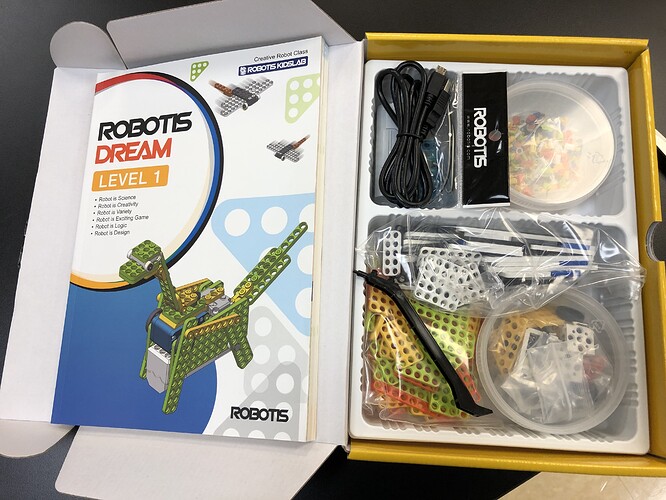My school doesn’t have a robotics program. Many of my students have never used robotics materials, but I wanted to challenge them to construct a motorized robot, using the Robotis Dream II Level 1 kit. When I introduced the project, some students seemed apprehensive, and others were gung ho. This project pushed some students outside of their comfort zones. I heard a few students say, “I don’t know how to build a robot.” But, by the end of the activity, all of my students were smiling, having fun, and were building their own motorized robots!
Any lingering apprehension eased with the first whir of a motor running, which made students delve into their projects even more. Students rushed to get their device to the stage where they could connect the battery pack and switch to the motor, so they too could see their robot coming to life.
Students who had no prior experience in building, engineering, or robotics, were surprised to see that the Dream kit had a book of ideas - a book of 12 robotic dreams that could be created by using the materials provided - assorted plates, rivets, motor, battery pack, and switch. Students took time in selecting which robot they wanted to build, based on what type of movement they wanted the robot to have. Some students picked a dinosaur (because dinosaurs are awesome), while others selected a windmill, duck, ladybug, or cow.
The individual robots were easy to construct; students followed the step by step instructions. I was pleasantly surprised to discover that the instructions relied mostly on images, making it easy for students to follow. This is also perfect for English Language Learners (ELL), because the activity isn’t hindered by potential language barriers.
After constructing their robots, I noticed that students were beginning to ask questions. They were asking about making modifications to their device. I overheard one student ask, “What if the dinosaur was wearing skis?” This provided the perfect opportunity for students to manipulate variables. They knew how the motorized robot moved, based on constructing the device per the instructions. Now, students could experiment by changing the base structure.
In fact, the dinosaur did end up wearing skis. It also ended up with a longer tail for counterbalance, and for some reason had a duck’s head by the end of the activity. The Dream II kit provided students with the ability to increase their confidence and self-efficacy in terms of robotics and engineering skills and activities.
This kit was perfect for my high school students, but could easily be used by students of different ages. These robots can easily be incorporated into any curriculum. Students can write a creative story involving their robot, calculate speed and velocity of movement, or explore the habitat in which their robotic animal might live. The possibilities are limitless!
Tips:
- Charge the batteries for students ahead of time
- Don’t spill the rivets.
- If the rivet gets stuck in the plate, use the fastener removal tool
- If the parts of the rivet fastening system get stuck together, the rivet can still be used. Simply lift the head of the push pin section before trying to reuse it
- The switch provides a forward, backward, and off option
